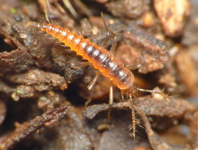Abstract
Erythrodiplax ana sp. nov. (male holotype, six male and three female paratypes), collected in Vereda wetlands (a unique Neotropical savanna environment) in Uberlândia (Minas Gerais) and Chapada dos Guimarães (Mato Grosso), Brazil, is described and illustrated. The new species fits in Borror’s Basalis Group, and can be distinguished from other species by the combination of the following traits: blue pruinosity dorsally on thorax and third to eighth abdominal segments; sides of the thorax olive-green; face ivory or olive-green; wings hyaline with a small apical brown spot on all four wings, well defined in females; male genitalia with sclerotized erectile posterior lobe and inflatable sac-like median process. Last instar larvae were reared in the laboratory, resulting in the description of the larva. We also followed this population for 13 months and present resulting biological notes and comments on ontogenetic color change in males, as well as longevity.
References
Borror, D.J. (1942) A revision of the libelluline genus Erythrodiplax (Odonata).Ohio State University, Columbus, 283 pp.
Carvalho, A.L., Ferreyra, N. Jr. & Nessimian, J.L. (1991) Descrição das larvas de três espécies do gênero Erythrodiplax Brauer (Odonata, Libellulidae). Revista Brasileira de Entomologia, 35 (1), 165–171.
Costa, J.M., Vieira, L.P. & Lourenço, A.N. (2001) Descrição de três larvas de Erythrodiplax Brauer, 1868, e redescrição das larvas de E. pallida (Needham, 1904) e E. umbrata (Linnaeus, 1758), com chave para identificação das larvas conhecidas das éspecies brasileiras (Odonata, Libellulidae). Boletim do Museu Nacional, 2001, 1–16.
Garre, A., Muzón, J. & Ardohain, D.M. (2008) Description of the final instar larvae of Erythrodiplax atroterminata Ris and E. corallina (Brauer) (Odonata: Libellulidae). Zootaxa, 1896, 45–50.
Garrison, R.W., Von Ellenrieder, N. & Louton, J. (2006) Dragonfly Genera of the New World. The Johns Hopkins University Press, Baltimore, 384 pp.
Guillermo-Ferreira, R. & Vilela, D.S. (2013) New records of Forcipomyia (Pterobosca) incubans (Diptera: Ceratopogonidae) parasitizing wings of Odonata in Brazil. Biota Neotropica, 13 (1), 360–362.
http://dx.doi.org/10.1590/S1676-06032013000100037Haber, W.A., Wagner, D.L. & De La Rosa, C. (2015). A new species of Erythrodiplax breeding in bromeliads in Costa Rica (Odonata: Libellulidae). Zootaxa, 3947 (3), 386–396.
http://dx.doi.org/10.11646/zootaxa.3947.3.5Klots, E.B. (1932) lnsects of Puerto Rico and the Virgin lslands: Odonata or dragonflies. Scientific Survey of Porto Rico, 14 (1), 1–107.
Limongi, J. (1991) Estúdio morfo-taxonómico de nayades de algunas especies de Odonata en Venezuela. 2. Memorias de la Sociedad de Ciencias Naturales La Salle, 49/50, 405–420.
Lozano, F., Muzón, J. & del Palacio, A. (2011) Description of final stadium larva of Erythrodiplax connata and E. basifusca and redescription of that of E. minuscula (Odonata: Libellulidae). International Journal of Odonatology, 14 (2), 127–135.
http://dx.doi.org/10.1080/13887890.2011.595354Muzón, J. & Garré, A. (2005) Descripción del último estadio larval de Erythrodiplax paraguayensis (Anisoptera: Libellulidae). Revista de la Sociedad Entomológica Argentina, 64 (1–2), 85–91.
Needham, J.G. & Westfall, M.J. (1955) A manual of the dragonflies of North America (Anisoptera). University of California Press, Berkeley, 615 pp.
Needham, J.G. (1904) New dragonfly nymphs in the United States National Museum. Proceedings of the United States National Museum, 27, 685–720.
http://dx.doi.org/10.5479/si.00963801.27-1371.685Nobre, C.E.B. (2016) Erythrodiplax leticia: Description of the female and updated geographic distribution (Odonata: Libellulidae). Zootaxa, 4067 (4), 469–472.
http://dx.doi.org/10.11646/zootaxa.4067.4.5Riek, E.F. & Kukalová-Peck, J. (1984) A new interpretation of dragonfly wing venation based upon Early Upper Carboniferous fossils from Argentina (Insecta: Odonatoidea) and basic character States in pterygote wings. Canadian Journal of Zoology, 62 (6), 1150–1166.
http://dx.doi.org/10.1139/z84-166Santos, N.D. (1967) Notas sobre a ninfa de Erythrodiplax connata fusca (Rambur, 1842) Brauer, 1868 (Odonata, Libellulidae). Atas da Sociedade de Biologia do Rio de Janeiro, 10 (6), 145–147.
Trapero-Quintana, A.D. & Reyes-Tur, B. (2008) Description of the last instar larva of Erythrodiplax fervida (Erichson, 1848) (Anisoptera: Libellulidae), with notes on the biology of the species. Zootaxa, 1688, 66–68.
Trapero-Quintana, A.D. & Novelo-Gutierrez, R. (2012) Description of the final stadium larva of Erythrodiplax bromeliicola Westfall, 2000 (Odonata: Libellulidae) with notes on variation in adults from Cuba. Zootaxa, 3545, 59–66.
Vilela, D.S., Ferreira, R.G. & Del-Claro, K. (2016) The Odonata community of a Brazilian vereda: seasonal patterns, species diversity and rarity in a palm swamp environment. Bioscience Journal, 32, 486–495.
http://dx.doi.org/10.14393/BJ-v32n2a2016-30491Von Ellenrieder, N. & Muzón, J. (2000) Description of the last instar larva of.Erythrodiplax nigricans. Odonatologica, 29, 267–272.
Watson, M.C. (1956) The utilization of mandibular armature in taxonomic studies of anisopterous nymphs. Transaction of the American Entomological Society, 81, 155–202.

